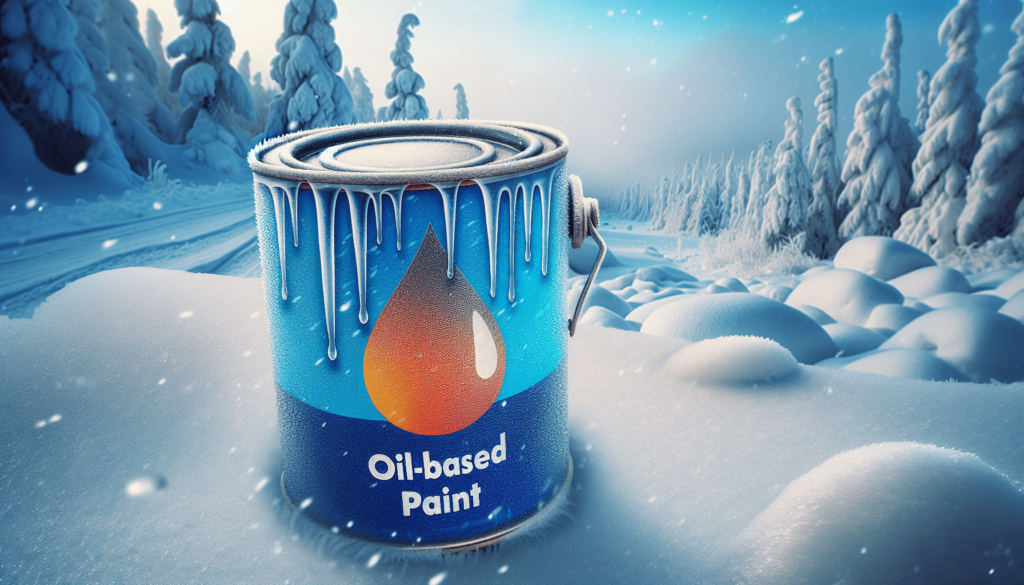In the intriguing piece, “Can Oil Based Paint Freeze,” the focus is primarily on your well-understood concerns about the physical changes oil-based paints undergo under freezing temperatures. You will glean substantial insights into the science behind the freezing point of oil-based paints, while also gaining a robust understanding of how extreme temperatures can impact the quality, consistency, and usability of these paints. This compelling overview, laden with key considerations and expert advice, allows you to grasp the largely unfamiliar, yet necessary, aspect of paint maintenance and storage.

What is oil-based paint?
Oil-based paint is a type of paint that is commonly used in both residential and commercial settings. It gets its name from its composition, specifically the type of solvent used in the formulation, which is oil. This distinguishes it from other types of paint, such as water-based paints, which have water as their solvent.
Composition and characteristics of oil-based paint
The primary components of oil-based paint are pigments, binders, and solvents. The pigments give the paint its color, binders hold these pigments together, and solvents keep the paint in liquid form until application. It is the oil used as a solvent that gives the paint its moniker. The typical oils used are linseed and synthetic alkyd.
Oil-based paints are known for their durability and rich, high-gloss finish. They cover surfaces thoroughly and do an excellent job of sealing off the material from moisture and damage, making them ideal for exteriors and high-traffic areas. However, they also take longer to dry than their water-based counterparts and require stronger, often more hazardous, solvents for cleanup.
Freezing point of oil-based paint
It is important to know the freezing point of oil-based paint, especially in colder climates or during the winter months. Below the freezing point, the paint starts to behave differently and may not perform as expected.
Factors affecting the freezing point of oil-based paint
Various factors affect the freezing point of oil-based paint. These factors include the specific type of oil used as solvent, the amount of solvent, the presence of other chemicals or additives, and the storage conditions where the paint is kept.
Typical freezing point of oil-based paint
The average freezing point for oil-based paint is around 15 degrees Fahrenheit (-9.44 Celsius). However, it can vary based on the specific formulation, from as high as 32 degrees Fahrenheit (0 Celsius), the freezing point of water, to as low as -40 degrees Fahrenheit (-40 Celsius).
Effects of freezing on oil-based paint
Freezing temperatures can have many negative effects on oil-based paint. The physical properties and quality of the paint are not the only things affected. There are also safety concerns to consider.
Physical changes in frozen oil-based paint
Freezing oil-based paint typically results in a separation of its components. The pigments and binders tend to coalesce and separate from the solvent. Once thawed, it may be challenging or impossible to remix these components back to a smooth, homogenous consistency.
Potential damage to paint quality
As a result of the separation and coagulation caused by freezing, the overall quality of the paint often suffers. Even if the paint can be mixed back to a somewhat fluid state, it may lose its ability to adhere well to surfaces, its coverage might be patchy and uneven, and its finish may be less than desirable.
Safety concerns during freezing and thawing
Beyond the quality of the paint, there are also safety considerations when handling frozen and then thawed oil-based paint. The freezing and thawing process can lead to the generation of pressure inside the paint can, which can create a risk of the container bursting open, particularly if it is metal. Moreover, if the paint quality has degraded, it may emit stronger fumes upon application, posing additional health risks.
Preventing oil-based paint from freezing
There are several ways to prevent oil-based paint from freezing, which, considering the potential issues and damages, should be a priority if you plan to store paint in a cold environment.
Storage recommendations for preventing freezing
The best way to prevent oil-based paint from freezing is to store it in a temperature-controlled environment. This environment should ideally be maintained above the paint’s lowest freezing point.
Temperature control options
There are various temperature control options, from the simple and cost-effective, such as storing paint cans in a heated indoor space, to more advanced solutions, such as renting a climate-controlled storage unit if a large quantity of paint needs to be stored.
Insulating paint containers during cold weather
Another option is to insulate the paint cans. Wrapping the paint containers with insulation materials such as bubble wrap or placing them inside an insulated container or box can help keep the cold out and the heat in.

Thawing and using frozen oil-based paint
If your oil-based paint freezes, all is not necessarily lost. There may still be ways to revive the paint, depending on the severity of the freezing.
Thawing methods for frozen oil-based paint
To thaw frozen oil-based paint, move the container to a warm location and allow it to warm up slowly and naturally. Avoid using direct heat or rapid warming methods, as these can cause pressure buildup inside the can and may lead to uneven thawing of the paint.
Assessing paint quality after thawing
After the paint has thawed, assess its quality by stirring it. If the paint can be stirred back to a smooth consistency, it may still be usable. However, if clumps remain or if the paint seems curdled or uneven, it is best to dispose of it properly and get a new batch.
Potential challenges and precautions during application
Even if the thawed paint seems usable, be aware that it might not perform as well as unfrozen paint. It may not adhere as well, the finish might be off, and the coverage might be patchy. It is also possible that it may produce more fumes during application, so ensure adequate ventilation and consider wearing a respirator.
Alternative paint options for cold climates
If you live in a cold climate, or frequently work in cold conditions, consider using paint types that are less susceptible to freezing damage.
Water-based paints as an alternative
In terms of freezing resistance, water-based paints, such as latex and acrylic paints, might be a better choice. These paints typically retain their properties better under freezing conditions and return to normal more easily once thawed.
Comparison of water-based and oil-based paints in freezing conditions
Even though water-based paints do freeze, they tend to manage the freezing and thawing process better than oil-based paints. Water-based paint often recovers its initial properties upon thawing, achieving a homogeneous consistency that enables it to be used without significant loss in quality or application performance.
Frequently asked questions about freezing oil-based paint
Many find the concept of paint freezing to be unfamiliar, leading to various questions. Here we answer some of the most frequently asked ones.
Can oil-based paint be salvaged after freezing?
Possibly, but not always. Whether or not frozen oil-based paint can be salvaged largely depends on the extent of the freezing and the thoroughness of the thawing. It also depends on the specific paint’s formulation and how much it was affected by the freezing. However, even if the paint is salvageable, it is likely to show some decrease in quality and performance.
What happens if oil-based paint is used after freezing?
If frozen oil-based paint is used after thawing, you might notice a number of issues. These can include poor adhesion to the surface, uneven coverage, and a less than satisfactory finish. Depending on how much the quality of the paint was affected, these issues can range from minor to severe.
Can cold temperatures affect the durability and longevity of oil-based paint?
Yes, exposure to cold temperatures or freezing can indeed affect the durability and longevity of oil-based paint. Freezing can damage the paint’s composition and alter its properties, resulting in a reduced shelf life and diminished performance when applied.
Can oil-based paint withstand repeated freezing and thawing cycles?
Repeated freezing and thawing cycles can have detrimental effects on oil-based paint, leading to a higher likelihood of irreversible damage to the paint’s composition and further degradation in the paint’s quality and performance.
Tips for storing oil-based paint in freezing weather
Be mindful of how and where you store your oil-based paint in colder weather.
Choosing appropriate storage locations
Choose storage locations that maintain a consistently warm temperature above the paint’s freezing point. When storing paint in a garage or shed, be sure that these locations are well-insulated and heated if necessary.
Ideal temperature range for paint storage
The ideal temperature range for storing oil-based paint is between 60 to 80 degrees Fahrenheit (15-27 degrees Celsius). These temperatures help ensure the paint stays in good condition.
Avoiding exposure to extreme temperatures
Protect your paint from freezing, but also avoid exposing it to excessive heat. Extreme temperatures on either end of the spectrum can affect the paint’s quality and longevity.
Conclusion
From understanding the freezing point of oil-based paint to the effects of freezing temperature on the paint’s quality, preserving the integrity of this type of paint in cold weather can indeed prove challenging. The best option is to avoid freezing conditions by storing your paint properly and choosing paints that can handle the cold if necessary.
Summary of key points
Freezing can significantly affect the quality and usability of oil-based paint, so it’s important to avoid letting your paint freeze. If the paint does freeze, it can, in some cases, be thawed and reused, but there’s a risk that the quality won’t be the same.
Best practices for handling oil-based paint in freezing conditions
So remember, when handling oil-based paint in freezing conditions, the best practices are to store the paint properly, thaw it carefully if it does freeze, and ultimately, to consider alternative types of paints that are less sensitive to cold weather.



